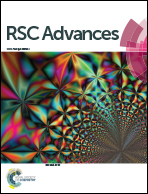Monitoring of 2-butanone using a Ag–Cu bimetallic alloy nanoscale electrochemical sensor
Abstract
Spherical shaped silver–copper alloy nanoparticles of 10–15 nm size were synthesized by an aqueous polymer solution method. The synthesized nanoscale Ag–Cu alloy was characterized by UV-Visible spectroscopy, X-ray diffraction spectroscopy, transmission electron microscopy (TEM), high resolution TEM, and energy dispersive spectroscopy. The XRD pattern showed high crystallinity and phase formation of the nanoparticles. The bimetallic alloy nanoparticles were coated over a well-polished glassy carbon electrode and the designed sensor was applied for the detection of a highly carcinogenic carbonyl compound, 2-butanone. Electrochemical studies revealed that PEI used as a capping agent also enhances the sensing of the modified electrode for the recognition of 2-butanone. The sensor developed from Ag–Cu (1 : 1) alloy nanoparticles showed the best sensing properties for the detection of 2-butanone as evidenced by electrochemical impedance spectroscopy and a 0.1 μM detection limit.


 Please wait while we load your content...
Please wait while we load your content...